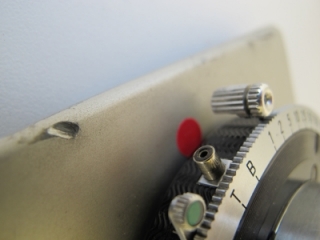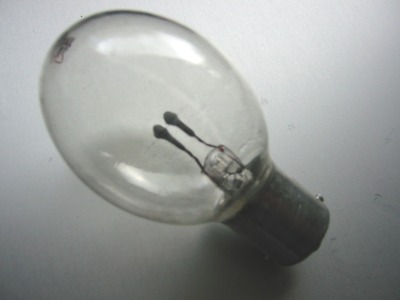

To be sure the bulbs flashes properly, clean the fitting.
Remove dust and corrosion with a Scotch Brite before using them.
The slash gun needs to be cleaned especially the contacts need some extra
attention. No corrosion should be left to guarantee reliable working.
Flashbulbs may be grouped in 4 classes according to the time of peak of illumination and some other characteristics.
Class F(ast) Bulbs: peak of illumination within 5 milliseconds. GE SM and Wabash SF
Class M(edium) Bulbs: peak in 20 milliseconds. Photoflash # 22 and Super-flash Press 40 and Westinghouse #11


Class S Bulbs: peak in 30 milliseconds. Photoflash # 50.
The duration of a flash should take plenty time
to cover the whole 4x5 inch film negative.
Time needed to illuminate the whole surface while the slit of the focal plane
shutter travels along the film from top to bottom.
If the flash goes out before the slit finished its travel along the film, the
negative would be exposed for just a small portion.
Therefore it is essential that you use the right bulb for the appropriate
shutter and film size.
The bigger the film size the longer the flash duration should be. However that
rule applies only for the focal plane shutter camera. The in between central
shutters such as the Grafex or Rapex shutter will do with a SM or SF flashbulb
according to the shutter speed you prefer.
In summary you can say that shooting with a Graflex camera equipped with a focal
plane shutter the following flashbulbs can be used.

Sylvania
2A FP (Focal Plane) E27 screw.
Comparable to GE No.31 or Philips PF45
Class FP: long peak focal plane shutter bulbs such as the # 31 and Sylvania super-flash No. 2A
The Sylvania 2 A -formerly Wabash- made for use with up to 4 x 5" Focal Plane shutter.
This Long peak bulb is specially made for stopping the action at 1/1000 sec. up to 160 Ft or 60 meter producing 80.000 lumen.
| Focal Plane Shutter 4x5 | |||
| Film speed ASA/DIN | 100/21° | 125/22° | 400/27° |
| Shutter speed 1/200 - 1/250 | 130 | 180 | 260 |
| Shutter Speed 1/400 - 1/500 | 90 | 130 | 180 |
| Shutter Speed 1/1000 | 65 | 90 | 130 |
To find the "f-stop" divide flash number by distance in feet between flashbulb and subject.
Focal Plane 4x5 inch film 100 ASA -
Shutter Speed 1/200 - 1/250
FLASHNUMBER = 130 - distance = 24 feet
130/24 = f stop 5,6
BULBS
For use with the
Supermatic Shutter
for the normal in between the lens shutters like the
Kodak Supermatic, Graphex or Graphic shutter or any other shutter equipped with
a flash bi-post or other synchronise contact.
For use with Bulbs, set control lever to M. This enables to ignite the bulb
milliseconds before the diaphragm is completely in open position to reach its
peak.



G.E. SM
Speed Midget flashbulbs have a single contact bayonet base for quick insertion. Overall length 2 1/2 inches.
Speed Flash flashbulbs. The effective flash duration last about 1/100 second with the SF and 1/200 for the SM at 1/2 peak
These bulbs are recognizable as they do not have wire or foil inside the bulb. The flash of about 5000 lumen seconds is produced by the primer mixture on the tips of the two lead in wires, igniting in an atmosphere of oxygen.


Efficient Bulb for use in midget reflectors. Very popular with the press. Not suitable for the Focal plane shutter for speeds faster than 1/30 sec.


A midget bulb with longer flash duration designed for use with the miniature focal plane. Camera size 35 mm to 2 1/4 x 3 1/4.
As you can see these bulbs are unsuitable for the larger 4x5 inch camera. Duration is too short



The upper side of the picture is dark, due to the fact that the GE#6 peaks too short to cover the 4x5 inch sheet film, during the time the focal plane shutter slit, travels along the film surface. We'll need Special Bulbs
These bulbs are designed for use with the larger focal-plane shutters up to 4 x 5 inches in film size. They have an extend peak of illumination, which is required for the focal-plane synchronization. Not to be used with front-shutter synchronization. The effective light output of these flashbulbs is around 80.000 lumen seconds.
In view of the larger area of the film across which the opening in the shutter curtain must travel and the larger mass of shutter curtain as well as the length of useful peak of the lamps, it is presently impractical to attempt to guarantee synchronization with a wide range and instantaneous speeds even when the long peak flash lamps are used. Because of the length of time required for the curtain opening to pass across the film and the length of useful peak of flash provided by the G-E No.31 and Wabash No. 2A lamps, it is necessary to control carefully the location of the curtain aperture, so as to insure even exposure of all of the film. The shutter curtain of any camera will pack when wound tightly on the roller. The packing of the curtain controls the location of the curtain aperture with respect to the film at the moment the circuit to the lamp is closed and it thus has a marked bearing upon synchronization with the useful peak of the flash during the time that the curtain aperture passes across the film, Consequently in order to allow a slight margin of safety to compensate for slight variations and tolerance in camera shutters and the flash lamps themselves, synchronization can be guaranteed only at the 1/1000 setting, with the back of the camera horizontal and the shutter curtain packed. It would be a good idea to fire the shutter a couple of times times, following which the connecting cord may be plugged in and the exposure may be made with the expectation that the shutter will be properly packed, so as to assure synchronization.
Because of the many variables involved, Graflex does not supply any accessory device for synchronizing Graflex focal-plane shutters. Various attachments for this purpose are on the market, and their manufacturers should be consulted for all information regarding them.
the worlds largest remaining distributor of Flashbulbs
TO GET THINGS WORK, YOU'LL NEED
the right
CONNECTING CORDS
A Graflite synchronizer is to be connected with a solenoid cord # 26703 2 x male. One male connector is a household connector with flat prongs and the other one is a connector with small round prongs. fig. 3
A Heiland synchronizer is to be connected with a solenoid cord: 1 household to 1 Bi-post female.
The Household to Bi-post sync cord connects the solenoid outlet on the battery case with the magnetic solenoid tripper on the lens board.
The solenoid if tripped by the red shutter main switch on the battery case, pulls the tripper from the shutter.
The female Bi-post Synchronizer connector doesn't fit to the shutter.
You can order your customized cord with the tips or plugs you want at Paramount.




Adjusting the Solenoid Graflex Synchronizer Provision for the use of flash
Home Graflex Cameras Flashing Synchronizer The Mendelsohn Speedgun
About Bulbs Testing your camera with the Flashunit Film Sheet or Roll Film Holder